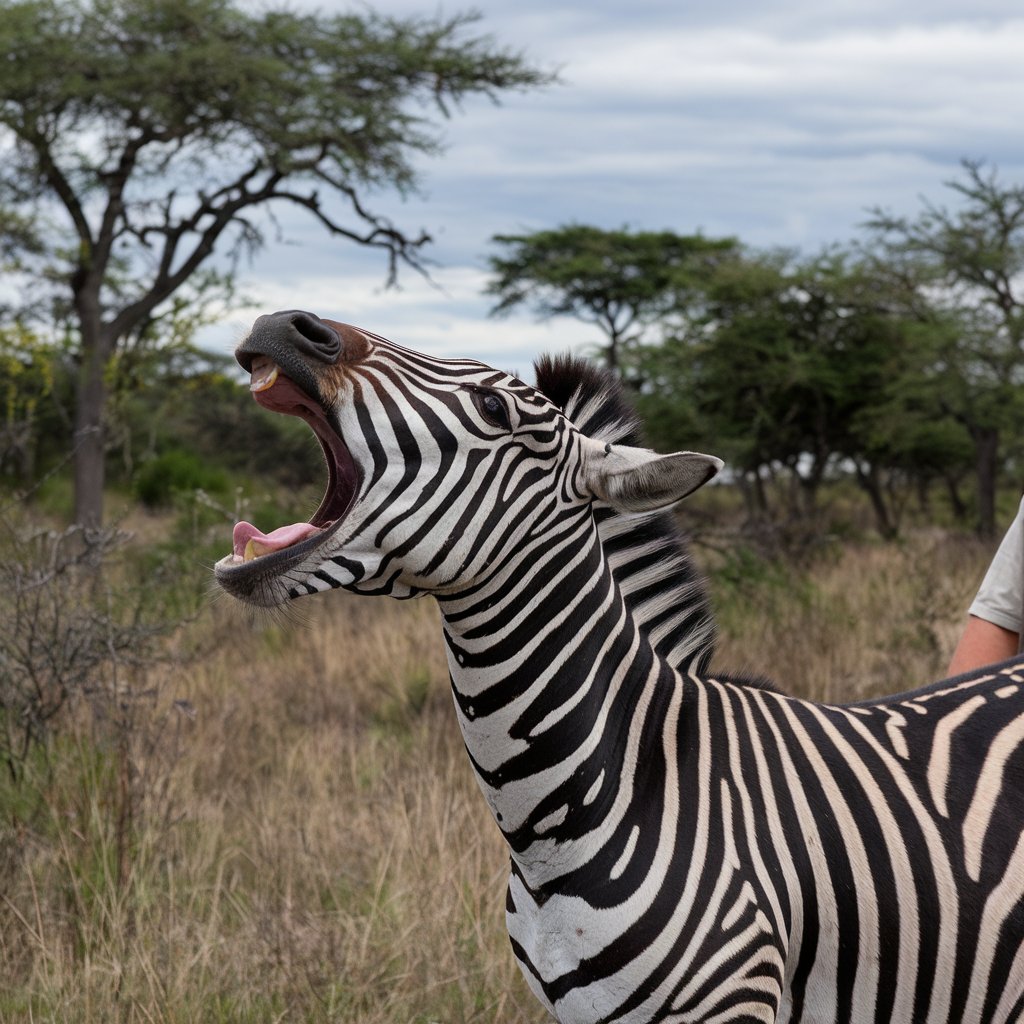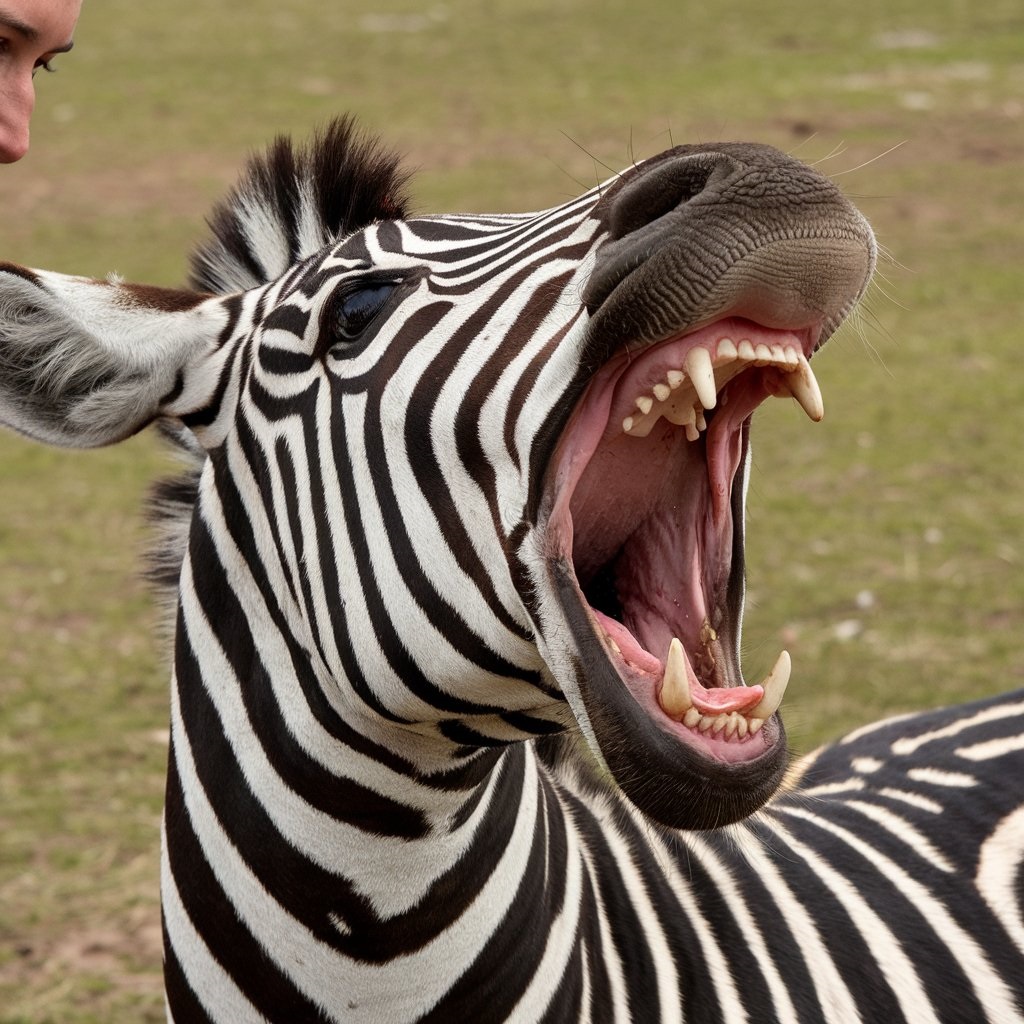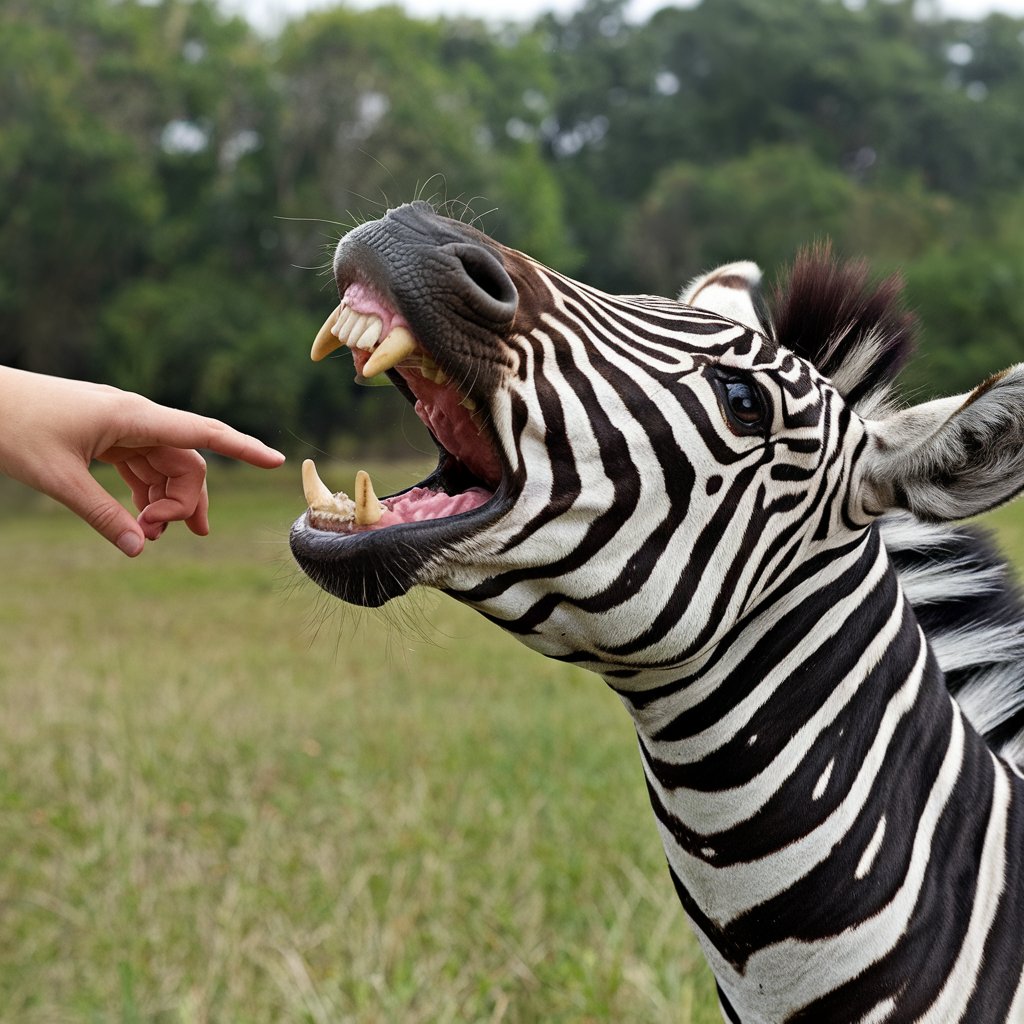When most people think of zebras, they picture peaceful animals grazing in the open African savannah, their distinctive black-and-white stripes blending into the landscape. These animals may seem harmless and docile, but do zebras attack humans? Are zebras as safe as they appear, or should we be cautious when encountering them?
In this in-depth article, we’ll explore the behaviors and characteristics of zebras, uncovering why and how they might attack, and what you need to know to stay safe. Zebras are often misunderstood, and this article aims to provide a clearer understanding of their nature, the triggers for aggression, and how to avoid dangerous encounters with them.
Certainly! Here’s a table with key facts and figures about zebras, including information on their species, behavior, and defense mechanisms:
| Fact/Attribute | Details |
|---|---|
| Species of Zebra | – Plains Zebra: Most common, found in open grasslands and savannas. – Grevy’s Zebra: Largest species, native to northern Kenya and Ethiopia. – Mountain Zebra: Adapted to rocky terrains of Southern Africa. |
| Zebra Habitat | – African Savanna: Common habitat for Plains zebra. – Semi-Arid Regions: Grevy’s zebra habitat. – Mountainous Regions: Home of Mountain zebra. |
| Zebra Lifespan | 20 to 30 years in the wild; up to 40 years in captivity. |
| Zebra Weight | – Plains Zebra: 300 to 450 kg (660 to 990 lbs). – Grevy’s Zebra: Up to 450 kg (990 lbs). – Mountain Zebra: 250 to 350 kg (550 to 770 lbs). |
| Zebra Speed | Up to 65 km/h (40 mph) when running. |
| Zebra Stripes | Each zebra has unique stripe patterns. Stripes provide camouflage in grasslands and confuse predators. |
| Zebra Kick Force | Can break bones, especially when directed at predators or humans. |
| Zebra Bite | Can cause lacerations and infections due to sharp teeth. |
| Zebra Herd Size | Up to 100 individuals in a herd, depending on the species and habitat. |
| Zebra Social Structure | Dominated by a single stallion, with mares and their offspring forming the core of the group. |
| Zebra Predators | Lions, hyenas, and cheetahs are common predators. Zebras use their speed and kicks for defense. |
| Zebra Aggression Triggers | Fear, stress (especially in captivity), and protecting offspring are key triggers for aggression. |
| Zebra Attack Injuries | Can include fractures, internal injuries, lacerations, and bruises due to the zebra’s powerful kicks. |
What Are Zebras? A Closer Look at These Unique Creatures
Before we dive into the more alarming side of zebras, it’s important to understand who they are. Zebras belong to the Equidae family, closely related to horses and donkeys. Their distinct black and white stripes make them stand out from other animals in the African savannah and grasslands. However, beyond their striking appearance, zebras are fascinating creatures with complex behaviors and social structures that are vital for their survival.

Zebra Species Breakdown
There are three main species of zebras, each with its own unique characteristics, behavior, and habitat:
- Plains Zebra: The most common and widespread species, found in the grasslands and savannas of sub-Saharan Africa. The Plains zebra is the largest and most well-known of the species, with a population that thrives in large herds.
- Grevy’s Zebra: Distinguished by narrower, thinner stripes, the Grevy’s zebra is endangered and primarily found in the semi-arid grasslands of northern Kenya and Ethiopia. Their numbers have significantly declined due to habitat loss and hunting.
- Mountain Zebra: Native to the mountainous regions of Southern Africa, particularly in Namibia and South Africa. The Mountain zebra is easily recognized by its more robust build and vertical stripes.
Zebras are social animals, living in herds with strong social bonds. Herds are typically led by a dominant male, with females and their offspring forming the rest of the group. This social structure is crucial for the zebras’ survival as it helps provide protection from predators.
Zebra Behavior in the Wild
Zebras live in herds and are herbivores, relying on grass and other plants for food. Their social structure is integral to their way of life, with each member of the herd playing a role in protecting one another from danger. However, when it comes to aggression, zebras are not known to be naturally violent, yet they are far from defenseless.
Zebra Communication and Social Structure
Zebras have a fascinating way of communicating with one another. They use a variety of vocalizations, from braying to snorting, and they communicate through body language, such as ear positioning and tail movements. The stripes that define them are not only for camouflage but also serve as a form of social communication, helping zebras recognize each other within the herd.
Zebra Herds and Defense Mechanisms
Zebra herds provide essential protection from predators. The strength of the herd lies in numbers, and zebras often use a motion dazzle effect to confuse predators. This effect involves the way their stripes appear to move when they are in motion, which can disorient a predator like a lion.
However, when cornered or in distress, zebras rely on a few powerful defense mechanisms. Their hind legs are capable of delivering a powerful kick, and they may also use their sharp teeth to bite. These defensive actions are most commonly seen when the zebra feels directly threatened or when it’s protecting its young.
Do Zebras Attack Humans? Unpacking Zebra Aggression
Zebras are generally non-aggressive creatures, but as with many wild animals, they can be dangerous when they feel threatened or cornered. Understanding the reasons behind zebra aggression is key to knowing when an attack is likely to occur and how to avoid it.
Zebra Aggression: A Rare but Real Threat
While zebras aren’t typically hostile toward humans, there have been documented cases of zebra attacks on humans, and these incidents are usually the result of misunderstanding or provocation. It’s important to remember that zebras, like many wild animals, do not seek out conflict but will engage in aggressive behavior if they feel their safety is compromised.
What Triggers Zebra Aggression?
Several factors can trigger aggression in zebras:
- Fear and Stress: Zebras, like many animals, will often resort to defensive behavior when they feel threatened. This is especially true in captivity, where stress levels can rise due to the unnatural environment and constant human presence.
- Protecting Offspring: Zebra mothers are highly protective of their young. If they perceive a threat to their calves, they will become defensive and may attack to safeguard their offspring.
- Territorial Instincts: In the wild, zebras defend their territory against other zebras and predators. In some cases, this territorial behavior can extend to humans if they encroach upon the zebra’s space.
Zebra Aggression vs. Predatory Behavior
Unlike predators, zebras are not typically aggressive unless they are under direct threat. Their aggression is driven primarily by defensive instincts rather than an inherent desire to harm others. In contrast to carnivores, zebras do not chase down prey but rather defend themselves when attacked.

Understanding Zebra Defense Mechanisms
Zebras have evolved several defensive behaviors to protect themselves from predators, and these same mechanisms are employed when they feel threatened by humans. Let’s take a closer look at the primary defense mechanisms zebras use when confronted with danger.
Zebra Kicks: The Power Behind Their Legs
One of the most effective defense mechanisms of the zebra is its kick. Zebras have incredibly powerful hind legs that are capable of delivering a devastating blow. A zebra kick is often described as one of the most forceful and dangerous kicks in the animal kingdom, capable of breaking bones and inflicting severe damage.
The force behind a zebra’s kick is enough to harm large predators like lions, and it can cause serious injuries to humans, particularly if the kick lands on the chest or head. The zebra kick is a primary tool for defending themselves when they are cornered or attacked.
Zebra Bites: Sharp Teeth as a Last Resort
While kicks are the primary method of defense, zebras can also use their sharp teeth to bite when they feel threatened. Biting is less common than kicking but can still be dangerous, especially if the zebra is cornered or otherwise unable to flee.
The Zebra’s Fight or Flight Response
Like most prey animals, zebras rely on a fight or flight response when threatened. In most cases, zebras will attempt to flee from danger by running at high speeds across the plains. However, if they cannot escape, they will use their powerful kicks and bites to defend themselves.
Documented Cases of Zebra Attacks
While zebra attacks on humans are rare, there have been several documented cases where zebras have injured people. These incidents often occur in captivity or in situations where humans get too close to wild zebras, causing stress or fear in the animals.
Real-Life Incidents
- Safari Park Attack: In one instance, a zebra at a safari park attacked a visitor who attempted to feed it. The zebra, startled and stressed, responded by kicking the individual in the chest, sending them to the hospital with serious injuries.
- Zoo Worker Incident: A zoo worker was bitten by a zebra while cleaning its enclosure. The zebra was agitated and lashed out, biting the worker’s arm and causing significant injury.
These attacks are often the result of human error—either the person got too close to the animal or misinterpreted the zebra’s body language. In general, zebras are not seeking out confrontation, but they will defend themselves if they feel cornered.
Are Zebra Attacks Dangerous?
Zebras are not known for being aggressive toward humans, but when they do attack, the consequences can be severe. The most dangerous aspect of a zebra’s defense mechanisms is its kick.
Injuries from Zebra Attacks
A zebra’s kick can cause serious injuries, including:
- Fractures: The force of a kick to the leg or torso can easily break bones, particularly in the ribs or limbs.
- Bruises and Lacerations: The sharp teeth of a zebra can cause deep cuts, while the kick can cause severe bruising.
- Internal Injuries: A powerful kick to the chest or abdomen can cause internal bleeding and damage to organs.
- Head Trauma: A kick to the head can lead to concussions or even fatal injuries, especially if the person is unprotected.

How to Avoid Zebra Attacks: Safety Guidelines
To minimize the risk of zebra attacks, it’s important to follow proper safety protocols when encountering these animals. Whether you are visiting a zoo, going on a safari, or interacting with zebras in the wild, understanding their behavior is key to staying safe.
Safety Tips for Interacting with Zebras
- Always maintain a safe distance: Keep a respectable distance from zebras, whether in the wild or in captivity. They are wild animals, and getting too close can provoke an aggressive response.
- Avoid startling zebras: Sudden movements or loud noises can cause a zebra to feel threatened. Always approach zebras calmly and quietly.
- Respect their space: Never try to feed or pet a zebra, especially if it’s in the wild. This can cause stress and potentially trigger defensive behavior.
- Follow safari and zoo guidelines: When on a safari or in a zoo, always adhere to the instructions of the guides. These professionals are trained to understand animal behavior and will ensure that you stay safe during your visit.
FAQs
Are zebras aggressive to humans?
Zebras are wild animals and can be aggressive, often attacking humans, which is why they were never domesticated. Their unpredictable nature makes them unsuitable as pets.
Is it safe to ride a zebra?
Riding zebras is not safe due to their natural aggression and strong evasion reflexes, making them difficult to control and train.
What is a zebra’s worst enemy?
Zebras face threats from lions, hyenas, wild dogs, and leopards, but humans pose the greatest danger through hunting and poaching.
Can a zebra support a human?
Zebras are not built to carry heavy loads, making it difficult for them to support a human rider due to their smaller size and build.
What happens if a zebra kicks you?
A zebra’s kick can be fatal, and they are responsible for more injuries to zookeepers than any other animal.
How friendly are zebras?
Zebras are aggressive and dangerous, known to kick and bite humans and even kill lions in certain situations.
What is the survival rate of a zebra?
The survival rate for zebra foals is around 50.3%, as many face significant challenges in their early life.
Can you befriend a zebra?
Zebras are not naturally friendly towards humans and have a strong instinct to avoid them, making them difficult to befriend or tame.
Is a zebra a good pet?
Zebras are not suitable pets due to their unpredictable behavior, aggression, and inability to be domesticated.
What are some negative facts about zebras?
Male zebras often engage in violent fights, sometimes to the point of killing each other through biting and kicking.
What is the lifespan of a zebra?
Zebras live an average of 20 years in the wild and can live up to 40 years in captivity, such as in zoos.
Is a zebra faster than a horse?
Zebras are fast runners, reaching speeds of 40mph, but horses can outrun them, with speeds up to 55mph.
Is a zebra intelligent?
Zebras are intelligent animals, capable of recognizing individual humans and remembering past interactions.
Can you make a zebra a pet?
While technically possible to tame, zebras are far more aggressive than horses, making them unsuitable for domestication or as pets.
How powerful is a zebra?
Zebras can weigh over 900 pounds and are known for their powerful kicks, capable of killing or crippling a lion.
What do you do if you see a zebra?
If you encounter a zebra, avoid approaching it and immediately call animal control to handle the situation safely.
Can a zebra be tamed?
Zebras can be tamed, but their aggressive nature and difficulties in training make them less practical than horses for domestication.
What is a zebra’s lifespan?
In the wild, zebras typically live up to 25 years, facing various survival challenges throughout their lives.

Conclusion: Are Zebras Really Safe?
Zebras are not naturally dangerous animals, but they are capable of defending themselves aggressively when they feel threatened. While zebra attacks on humans are rare, they do happen, especially in situations where the animal feels cornered, stressed, or provoked. By understanding zebra behavior and respecting their space, you can greatly reduce the risk of an attack.
In the end, zebras are wild animals, and like all wildlife, they should be treated with respect and caution. Maintaining a safe distance and observing them from afar is the best way to enjoy these incredible creatures without putting yourself in harm’s way.
So, are zebras safe? In general, yes—unless you push them too far. Stay safe, be aware, and always respect wildlife, and you’ll be able to enjoy these magnificent creatures without risk.
Read more knowledgeable blogs on Flowy Magazine

James Clair is a passionate writer and researcher with a deep fascination for animal behavior and its intricate connection to human life. With a background in [relevant field of study, e.g., zoology, psychology, ethology], James has spent years studying the natural world, focusing on how animals’ actions and instincts impact human emotions, behavior, and society.
His expertise in [specific topics or regions of focus, e.g., canine psychology, animal communication, wildlife conservation] has led to numerous published works and collaborations with renowned researchers and institutions. Through his work at Flawy Magazine, James aims to bridge the gap between scientific research and public understanding, offering insightful, accessible articles that explore the complex relationship between humans and animals.
When he’s not writing, James enjoys [personal hobbies or interests, e.g., hiking in nature, volunteering at animal shelters, photography] and is an advocate for [cause or charity related to animals or conservation]. His mission is to inspire readers to see animals not just as companions or creatures of the wild, but as beings whose behavior holds valuable lessons for us all.









